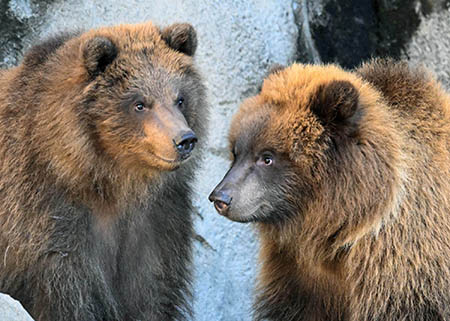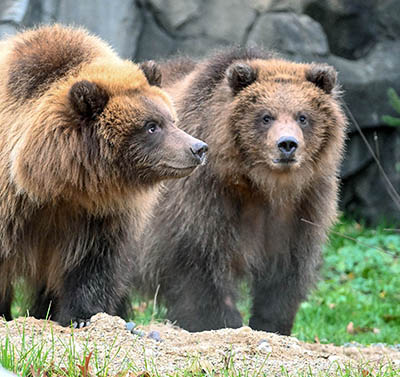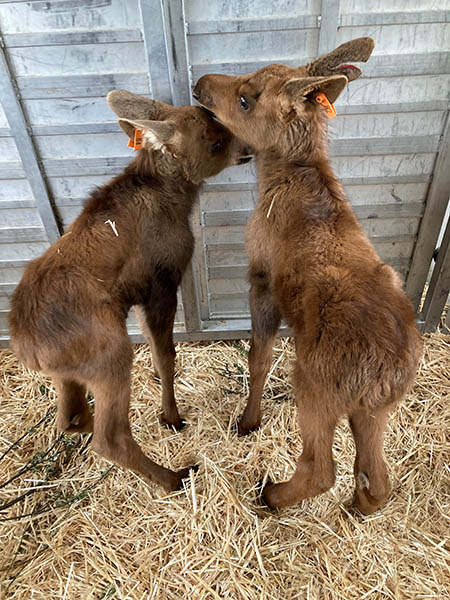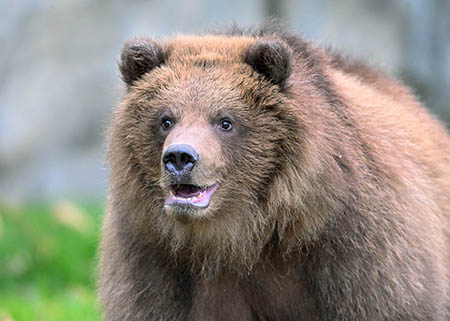Alaska Fish & Wildlife News
January 2024
Alaska Bears in Chicago
Bears, moose, deer and opossums in zoos in 2023

Two orphaned brown bear cubs from Alaska have a new home in Chicago. The 11-month-old brother and sister bears, Tim and Jess, made their public debut at the Brookfield Zoo in December, 2023.
The Alaska Department of Fish and Game oversees the placement of wild animals such as bears in zoos and other facilities. It’s a tricky process and options vary year-to-year, but 2023 proved to be an unusually successful year. Wildlife biologist Stephanie Bogle manages placements and permitting. She said 10 bears were placed (four brown bear and six black bear), several moose calves, a Sitka black-tailed deer, a squirrel, and five invasive opossums.
A major problem with placement is finding an appropriate facility. Bears are long-lived and most zoos or wildlife parks capable of caring for a bear already have one (or more). This year there were a plethora of placement options.
“Every year I do more networking, and make more contacts,” Bogle said. “I reached out to people early on, and a lot of people reached out to me and got back to me. We had a ton of requests for brown bear this year.”
Zoos want young animals. Adult animals do not adjust well to captivity, and are much more difficult to transport and handle. Fish and Game as an agency is not set up to do rehabilitation, so when animals are available, they’re small, young orphans.
“That’s really optimal for a facility like a zoo,” Bogle said. “It makes it possible to teach them things like (being tolerant with) getting veterinary care. Younger bears can be trained to be comfortable traveling in a crate, which really helps - you don’t need to sedate them to transport them. When they are bigger and older it’s harder for them to adapt, and you don’t know if they’ll get along with the other animals. Young bears stick together with other bears, and it’s easier to integrate them in with other bears.”
An adult brown bear that has been captured by wildlife officials for being a potentially dangerous urban nuisance bear is not a good candidate for placement. In August of 2023, Fish and Game began receiving multiple reports of brown bears getting into unsecured garbage in south Anchorage. The department, Anchorage police and the Alaska State Troopers worked to address the reports and the attractants - brown bears will defend food sources and can become serious public safety threats. In early September, three bears were captured, a sow and cubs, and the adult was euthanized. Once placement for the cubs was verified, Bogle arranged for temporary care at the Alaska Zoo in Anchorage.

The Alaska Zoo works closely with the department, providing essential short-term care and assisting with processing and transportation. The two sibling cubs were in the Alaska Zoo with another brown bear cub that had also been placed and was awaiting transport to Wildlife Safari in Oregon.
Bogle said the fourth brown bear cub placed in 2023 came in early in the year, a male bear from Hood Bay, on Admiralty Island, and he went to a wilderness sanctuary facility in Pennsylvania.
Bogle said the Anchorage housing for the bears was short term.
“We try to get them out as fast as we can, particularly in the spring,” she said. “They take the space that could go to another orphan if one comes in. If the zoo maxes out on what they can hold, we don’t have another option.”
Timing is also a factor, as summer months are usually too hot to transport animals. Perhaps not when departing Anchorage, but almost certainly when arriving at the destination in the Lower 48. “With moose calves we’ll wait until fall,” Bogle said. Animal welfare is the priority, but a four or five month delay means moving older and bigger calves, which are harder to transport.
Animals need more than housing when they come in. Moose and bears are de-wormed, which can take time. Sometimes animals need medical attention, or need time to recover and gain strength before they can be transported. Sometimes they aren’t well when they come in, and die within a day or two.
Some have unseen injuries. Bogle noted one moose calf she helped examine this summer that seemed perfectly fine at first. Close examination revealed a bite with a serious infection.
“A lot of animals will hide injuries, they don’t want other animals to see their weakness,” she said. “They hide that they’re not okay, so they don’t become prey.”
Wild animals often leave their offspring unattended for periods of time while they feed. It’s normal, and people should not “rescue” baby animals in the spring and early summer. If someone is concerned, or the mother has been killed by a vehicle or something similar, they should call the local Fish and Game office.

Most orphans are initially sent to the Alaska Zoo because it is a large facility in a logistically convenient location. The Alaska Wildlife Conservation Center is also occasionally able to temporarily care for some orphans, and this spring housed several moose calves. Bogle said she was able to place a moose calf with the reindeer farm in Palmer, and the others with facilities in Pennsylvania.
The Sitka black-tailed deer was from Kodiak Island and is now permanently at the Alaska Zoo. Grubby the opossum also went to the Alaska Zoo.
Grubby was statewide news in the spring of 2023. The opossum stowed away in a shipping container from Washington state and popped out in Homer. Named because she was discovered near Homer’s Grubstake Avenue, she eluded capture for a month. A police officer grabbed her in late May and she was sent to the zoo. Area residents later began seeing joeys – baby opossums – and it became evident that Grubby had given birth while on the lam. It appears now that all the baby opossums were captured this past summer.
“One of the offspring went to the Oregon Zoo,” Bogle said. “Two went to the Maryland Zoo in Baltimore. I actually helped with the transport for those in Anchorage.”
Making the Grade
State and federal laws determine what constitutes an appropriate facility for animals, but state laws regarding captive wildlife vary widely. Fish and Game has high standards for placing animals.
“We have an application process, and we need to see all the certifications they have,” Bogle said. “A USDA exhibitors license – that certification is required.” The American Zoological Association has a voluntary accreditation, a set of standards that is important but not required.
“We also require that it’s a permanent home. We don’t want to bounce animals around to another facility.”
She said the outdoor features of the enclosure are considered, the rocks and trees and landscaping. “We really look at their facilities – they send us pictures and maps of holding areas, their veterinarian care facilities, and the other living areas in case they don’t get along with other animals.”

She said enrichment activities for the animals are also very important. Toys, puzzles and games, things that will mentally stimulate them. For a bear, that might be an empty beer keg they roll around, a partially submerged barrel floating erratically in their swimming area, treats frozen into blocks of ice they chew apart and lick, and things they can tear apart.
Conservation education must be a mission of the facility. “As the Division of Wildlife Conservation, that is extremely important to us,” she said. “We ask them to send examples of their educational programs, and talks and presentations they do, of their signs and exhibits and displays – everything tied into their wildlife conservation education.”
She noted a couple details that have impressed her regarding the Brookfield Zoo in Chicago.
“They wanted the backstory of the cubs, the story of their mom and the huge nuisance bear issue, something we can learn from and how can that be prevented. If she had not been rewarded with trash, that wouldn’t have happened.”
The Brookfield Zoo also has another Alaska bear, Axhi, who came from Admiralty Island in Southeast in 1996, and has been there almost 30 years, “Which speaks to their favor, that they’ve had a bear that long,” she said. He’s huge, 1,400 pounds.
Axhi is currently hibernating, but the cubs are not. They are acclimating and getting familiar with their area. They’re also gaining weight. They weigh about 115 pounds now, and are putting on fat.
The Brookfield Zoo announced the cubs’ debut on Dec. 11. The announcement said, “According to their care team, Tim is very calm, a bit larger and has much darker fur; Jess is quite bold, a bit smaller, though she is so very fluffy she appears to be the same size. The cubs are very bonded and sleep in a big nest together at night.”
More
Living with bears and handling bear attractants
Placing Alaska Wildlife in Zoos – Homes are Hard to Find (Alaska Fish and Wildlife News, March 2023)
Subscribe to be notified about new issues
Receive a monthly notice about new issues and articles.
